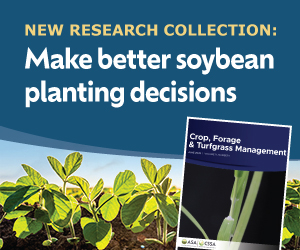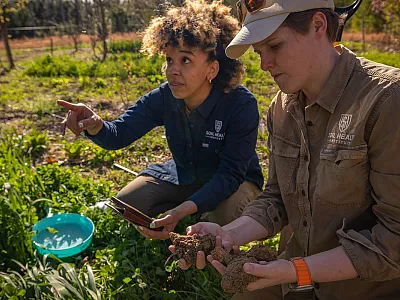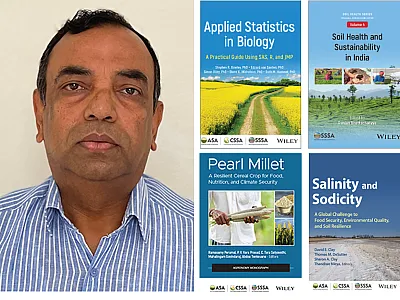Replacing Toxic Tall Fescue With a Nontoxic Forage
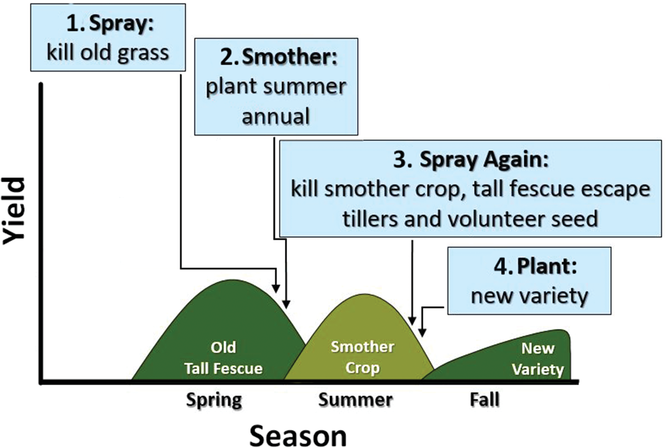

Tall fescue is among the most popular cool-season pasture grasses in the United States and is widely grown in other countries with temperate climates. In the United States, nearly all tall fescue pastures planted before 1980 are infected with Epichloë coenophialum, a microscopic fungus. The common strain of this fungus produces toxins called “ergot alkaloids,” such as ergovaline. These ergot alkaloids cause fescue toxicosis, a severe livestock disorder that costs U.S. livestock producers at least $1 billion each year. At present, there is no medical cure for fescue toxicosis. There are, however, proven management strategies that lessen the effect of toxicosis. One is the replacement of toxic tall fescue with varieties that are endophyte free or contain novel endophytes. Earn 1 CEU in Integrated Pest Management by reading this article and taking the quiz at https://web.sciencesocieties.org/Learning-Center/Courses.
Tall fescue is among the most popular cool‐season pasture grasses in the United States and is widely grown in other countries with temperate climates. In the United States, nearly all tall fescue pastures planted before 1980 are infected with Epichloë coenophialum, a microscopic fungus. This fungus is often referred to as an “endophyte” because it grows inside (“endo”) the plant (“phyte”). The common strain of this fungus produces toxins called “ergot alkaloids,” such as ergovaline. These ergot alkaloids cause fescue toxicosis, a severe livestock disorder that costs U.S. livestock producers at least $1 billion each year.
At present, there is no medical cure for fescue toxicosis. There are, however, proven management strategies that lessen the effect of toxicosis. One is the replacement of toxic tall fescue with varieties that are endophyte‐free or contain novel endophytes. This will be the topic of this article, which was originally published in the book, Fescue Toxicosis and Management, 2nd edition.
Editor’s Note
This article is republished in a slightly modified form from a section of the book Fescue Toxicosis and Management, 2nd edition. The complete book is available for purchase by visiting http://bit.ly/3ZbdURz or scanning the QR code.
Completely replacing toxic tall fescue with a nontoxic forage is the only way to ensure that fescue toxicosis is no longer a problem. It is also the best way to avoid recurring input costs and time commitments that are required to manage the toxic tall fescue, should the original pasture be retained. Before replacing toxic tall fescue with a nontoxic forage, the following criteria should be considered:
- Endophyte level. If endophyte infection level is low (less than 20% infected tillers), replacing it with a new variety is usually not necessary or economically justifiable.
- Land ownership. The replacement process may not be economical for short‐term rental arrangements.
- Landscape. Replanting into terrain with steep slopes is usually impractical.
- Livestock class. Toxic tall fescue replacement is critical with high‐performance animals. Pastures that support high‐value horse‐breeding programs and grass dairies are candidates for mandatory replacement with nontoxic tall fescue. Beef stocker, replacement heifer, and cow–calf operations should also consider replanting to nontoxic fescue.
- Grazing management. If the pasture will be grazed continuously, close to the ground, and with the same low level of management used on toxic tall fescue pastures, replanting to a novel endophyte tall fescue may not be a good idea. Though the new varieties do not require a high degree of management, they do require some level of management and will not survive abuse.
- Seed production. Some new varieties that contain novel endophytes cannot legally be harvested for seed, so additional income from seed production may not be expected without being licensed for that purpose by the seed company.
Spray–Smother–Spray
Replacement of toxic tall fescue often employs a method called “spray–smother–spray.” In this method, the old tall fescue is sprayed with a systemic, non‐selective herbicide (such as glyphosate). The first spray kills most of the tall fescue plants. Next, the field is no‐till drilled with an annual smother crop that is grazed or cut for hay. Later, the field is sprayed again, just prior to planting the new variety (Figure 1).
The reason for such an involved process is because old stands of tall fescue are not easily eradicated. A single spray, even if followed by cultivation, will not kill all of the existing plants. Some infected tillers escape the herbicide because they are covered by dung piles, thatch, or other material. In addition, infected seed can survive, as they shatter from old plants and remain in the soil. These escape tillers and old seed can increase throughout the field and eventually reestablish the old stand of tall fescue.
In the spray–smother–spray method, the smother crop should be a light‐filtering forage. The smother crop forms a thin canopy that partially shades the ground while allowing light to penetrate. This stimulates the growth of escape tillers and volunteer seedlings of old tall fescue. When the smother canopy is finally removed, nearly all escape tillers and volunteer seedlings of toxic tall fescue are growing vigorously and exposed to the second application of herbicide.
After the second spray, the new variety can be no‐till drilled into the stubble of the smother crop. If the new variety is a cool‐season perennial, and if it forms a uniform, dense canopy, the newly established stand will not be re‐infected unless the stand thins. This is because only seed infected with a living endophyte or residual surviving plants can spread the endophyte.
The spray–smother–spray method works for both spring and fall plantings. With fall plantings, the toxic pasture should receive its first herbicide application in the spring before seeds are mature. The smother crops that typically follow the first spray are pearl millet or sorghum‐sudangrass. The smother crop should be managed normally, carefully monitoring the potential for nitrate or prussic acid buildup. After the crop is grazed or harvested, the field is sprayed a second time, and the new variety is no‐till drilled as recommended for the fall plantings in that region.
Spring plantings are not advised because of weed pressure and the inability to form an adequate root system before the hot, dry summer. However, if spray–smother–spray is used to prepare for a spring planting, the first spray would occur in late summer or early fall, and the smother crop would be a winter annual. Winter annuals that are most common include wheat, rye, or another cereal crop. Annual ryegrass should be avoided because it forms a thick, dark canopy, which prevents light penetration and discourages growth of the escape tillers and volunteer seedlings that must be killed by the second spray. Also, annual ryegrass has an aggressive spring growth pattern, which can hamper the establishment of the new variety.
It is important to note that the spray–smother–spray method is flexible. Smother crops can be planted back to back, providing multiple harvests and ensuring kill of persistent weeds like annual bluegrass. Also, there are many species that can be used as smother crops. Some of these are glyphosate‐resistant row crops, and others are legume crops that can be produced with standard grass herbicides. Others are broadleaf forages, such as chicory.
Spray–Wait–Spray
An alternative method to spray–smother–spray is called “spray–wait–spray.” This method requires that toxic tall fescue plants be mowed in the spring to prevent viable seed production, grazed through the late spring and early summer, and then sprayed with glyphosate. Six weeks later, the field is sprayed a second time. Soon after the second spray, the new variety can be no‐till drilled into the killed stubble at recommended seeding rates. The spray–wait–spray method has been tested on experimental and farm scales for over 10 years in the southern United States and has consistently eradicated toxic tall fescue (Hill et al., 2010).
In general, new tall fescue plantings should not be seeded with companion legumes. Legumes such as red clover and white clover germinate quickly and form a canopy over the new grass seedlings, causing harmful competition. In addition, companion legumes restrict the use of broadleaf herbicides. This makes weed control more difficult during establishment year. If the field is not weed infested, only non‐aggressive legumes should be seeded. Such legumes would include birdsfoot trefoil and other species with poor seedling vigor.
Legumes such as red and white clovers can be easily seeded into an established stand of tall fescue. Furthermore, previous knowledge of the field may indicate a natural seed supply of white clover, which can regenerate into a fescue–clover mixture.
New Tall Fescue Varieties
New varieties of tall fescue are the forage of choice when replacing old, toxic tall fescue. This is because tall fescue, whether an old or new variety, has a long growing season, can be stockpiled for winter grazing, and is widely adapted to many regions. New varieties of pasture‐type tall fescue are nontoxic to ruminant livestock. These include varieties with no endophyte, called “endophyte‐free,” and those that contain a special endophyte, called a “novel endophyte.”
Endophyte‐free varieties were developed in the 1980s (Hoeveland et al., 1983). After plant breeders removed the endophyte from tall fescue seed (Pedersen & Sleper, 1988), their new varieties produced no symptoms of toxicosis in livestock. When compared with their infected counterparts in side‐by‐side feeding trials, the endophyte‐free varieties dramatically increased weight gain, reproductive performance, and milk production (Table 1). As a result of this single scientific event (removal of the toxic endophyte), the new varieties rendered tall fescue nontoxic and highly nutritional.
| Location of Research | Change in Animal Performance (relative to control) | Class of Livestock | Forage or Feed Type |
|---|---|---|---|
Average daily gain (lb) | |||
| Alabama | -0.84 | Steers | Hay |
| Alabama | -1.67 | Steers | Seed |
| Alabama | -0.84 | Steers | Pasture |
| Kentucky | -0.55 | Steers | Pasture |
| Georgia | -0.29 | Steers | Pasture |
| Alabama | -0.77 | Steers | Pasture |
| Texas | -1.12 | Steers | Pasture |
| Arkansas | -0.44 | Steers | Pasture |
| Mississippi | -0.48 | Steers | Pasture |
| Missouri | -0.90 | Steers | Pasture |
| Virginia | -0.53 | Steers | Pasture |
| Oklahoma | -0.51 | Steers | Pasture |
| Tennessee | -0.42 | Steers | Pasture |
Milk production (lb per day) | |||
| Alabama | -11.00 | Beef cows | Pasture |
| Kentucky | -16.94 | Dairy cows | Green chop |
| Missouri | -3.96 | Beef cows | Pasture |
Intake (lb per day) | |||
| Alabama | -1.98 | Steers | Hay |
| Alabama | -8.80 | Steers | Seed |
| Kentucky | -1.98 | Steers | Seed |
| North Carolina | -1.10 | Lambs | Hay |
| Georgia | -4.62 | Steers | Pasture |
Note. Sources: Sleper & West, 1996; and Stuedemann & Hoveland, 1988.
However, the endophyte‐free varieties did not persist well, and producers who planted these varieties began reporting problems with stand loss. Their reports were followed by scientific studies revealing that endophyte‐free varieties were susceptible to drought (West et al., 1993). Researchers eventually revealed that endophyte‐free tall fescue is highly susceptible to plant disease, insects, overgrazing, and mineral‐deficient soils (Latch, 1993; Malinowski & Belesky, 2000).
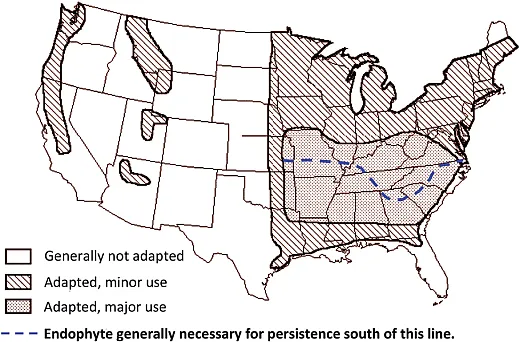
Researchers have suggested that this lack of persistence is caused by several factors that work together in a phenomenon called “accumulated stress.” An example of accumulated stress in endophyte‐free tall fescue can be seen from the dual effects of drought and soil‐borne nematodes (Elmi et al., 2000); as roots are degraded by nematodes, plants fail to take up moisture and suffer from drought stress, a stress that is already occurring because endophyte‐free plants lack drought‐tolerance mechanisms. The compounding effects of nematodes and drought place the entire pasture at maximum risk.
Although they lack persistence in southern locations or on marginal soils, endophyte‐free varieties can survive in northern environments that have limited stress from drought, diseases, and insects (Figure 2). With proper grazing management, endophyte‐free varieties have occasionally persisted longer than five years in southern regions as well. In such cases, however, the endophyte‐free tall fescue pastures were planted on soils with good water availability, were rotationally stocked, and were rested from grazing during summer months (Vibart et al., 2008).
In the past, producers who grew tall fescue faced a dilemma. They could either plant a traditional endophyte‐infected variety, such as Kentucky 31, or an endophyte‐free variety. Toxic Kentucky 31 would result in excellent plant persistence but poor animal performance. Endophyte‐free varieties would result in the opposite—excellent animal performance but poor plant persistence.
Since 2002, producers have had a third choice. They can plant tall fescue infected with a novel endophyte. A novel endophyte is an endophyte that produces little or no ergot alkaloids and is not toxic to ruminant livestock.
The first cultivar with a novel endophyte was developed by removing the common endophyte and then inserting a new endophyte (Bouton et al., 2002; Figures 3 and 4). The new endophyte was the same fungal species as the common endophyte, but it was a different strain. Since then, many novel endophytes have been inserted into tall fescue. They have improved the plant persistence that was lacking in endophyte‐free varieties.
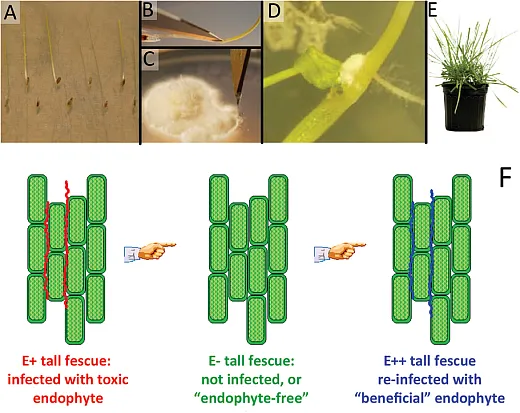
Novel endophyte varieties that have been properly screened and researched are nontoxic to sheep, goats, beef cattle, and dairy cattle (Bouton et al., 2002; Nihsen et al., 2004; Parish et al., 2003a, 2003b). Because some novel endophytes produce low concentrations of ergot alkaloids, and because horses are especially sensitive to ergot alkaloids, care should be taken when selecting a novel endophyte variety for equine operations. This is especially true in the case of brood mares.
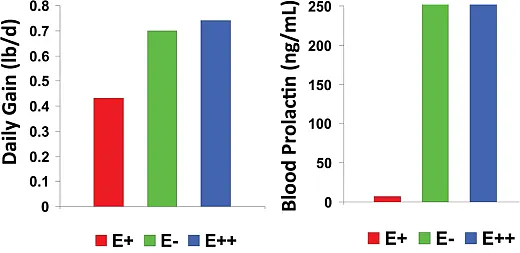
Some novel endophyte varieties have been tested extensively in grazing trials with various classes of livestock. These varieties produce excellent lamb (Bouton et al., 2002; Parish et al., 2003a; Figure 4) and stocker steer gains (Beck et al., 2009; Franzluebbers & Stuedemann, 2006; Gunter & Beck, 2004; Johnson et al., 2012; Kallenbach et al., 2006; Latch, 1993; Table 2), similar to gains observed on endophyte‐free tall fescue. In some cases, novel endophyte tall fescue can provide higher gains per acre than either toxic tall fescue or wheat–cereal rye forage systems (Beck et al., 2008). In cow–calf systems, replacing toxic tall fescue with novel endophyte varieties can increase weaning weights by 40 to 60 lb in research settings (Caldwell et al., 2013; Watson et al., 2004), with on‐farm reports ranging from 70 to 115 lb. In addition to increased weaning weights, conception rates also increase when novel endophytes are grazed, particularly in spring calving operations (Caldwell et al., 2013).
| Novel Endophyte | Location | Pasture Endophyte Status (Average daily gain in lb) | ||
|---|---|---|---|---|
| Toxic Endophyte | Endophyte-free | Novel Endophyte | ||
Average daily gain (lb) | ||||
| ArkShield | Fayetteville, AR | 0.90 | 1.50 | 1.40 |
| ArkShield | Mt. Vernon, MO | 0.55 | 1.25 | 1.25 |
| MaxQ | Calhoun, GA | 1.03 | 1.84 | 1.81 |
| MaxQ | Eatonton, GA | 1.14 | 2.24 | 1.91 |
| MaxQ | Hope, AR | 1.27 | 2.36 | 1.94 |
| MaxQ | Watkinsville, GA | 1.25 | 1.67 | 1.76 |
| MaxQII | Lexington, KY | 1.39 | 1.78 | 1.78 |
| E34 Plus | Hope, AR | 1.27 | 2.36 | 2.06 |
Note. Sources: Adapted from Beck et al., 2009; Franzluebbers & Stuedemann, 2006; Johnson et al., 2012; Nihsen et al., 2004; Parish et al., 2003b.
In comparison to varieties infected with the toxic endophyte, varieties with novel endophytes are grazed for more hours per day and are consumed in larger amounts per day (Parish et al., 2003a, 2003b). Pure stands of novel endophyte tall fescue are also grazed closer to the ground than are stands of toxic tall fescue, allowing higher forage intake for the animal but increasing grazing pressure on the plant (Figure 5). In hay, endophyte status may not affect preference by cattle (Caldwell et al., 2013).
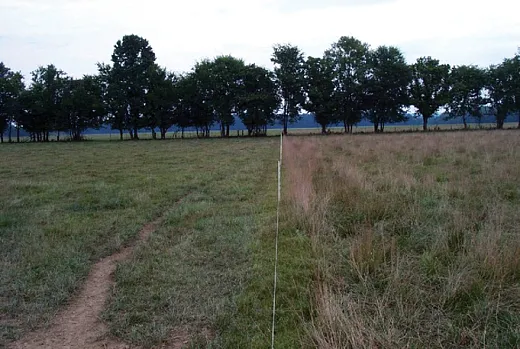
References
Beck, P.A., Gunter, S.A., Lusby, K.S., West, C.P., Watkins, K.B., & Hubbell, D.S. III. (2008) Animal performance and economic comparison of novel and toxic endophyte tall fescues to cool‐season annuals. Journal of Animal Science, 86, 2043–2055. https://doi.org/10.2527/jas.2007‐0522
Beck, P.A., Stewart, C.B., Gunter, S.A., & Singh, D. (2009) Evaluation of tall fescues for stocker cattle in the Gulf Coastal Plain. The Professional Animal Scientist, 25, 569–579
Bouton, J.H., Latch, G.C.M., Hill, N.S., Hoveland, C.S., McCann, M.A., Watson, R.H., Parish, J. A., Hawkins, L. L., & Thompson, F.N. (2002) Reinfection of tall fescue varieties with non‐ergot alkaloid‐producing endophytes. Agronomy Journal, 94, 567–574. https://doi.org/10.2134/agronj2002.5670
Caldwell, J.D., K.P. Coffey, J.A. Jennings, D. Philipp, A.N. Young, J.D. Tucker, D.S. Hubbell, III, T. Hess, M.L. Looper, C.P. West, M.C. Savin, M.P. Popp, D.L. Kreider, D.M. Hallford, & C.F. Rosenkrans, Jr. (2013) Performance by spring and fall‐calving cows grazing with full, limited, or no access to toxic Neotyphodium coenophialum‐infected tall fescue. J. Anim. Sci, 91:465–476. https://doi.org/10.2527/jas.2011‐4603
Elmi, A.A., West, C.P., Robbins, R.T., & Kirkpatrick, T.L. (2000) Endophyte effects on reproduction of a root‐knot nematode (Meloidogyne marylandi) and osmotic adjustment in tall fescue. Grass Forage Science, 55, 166–172.
Franzluebbers, A.J., & Stuedemann, J.A. (2006) Pasture and cattle responses to fertilization and endophyte association in the southern Piedmont, USA. Agriculture, Ecosystems & Environment, 114, 217–225. https://doi.org/10.1016/j.agee.2005.10.003
Gunter, S.A., & Beck, P.A. (2004) Novel endophyte‐infected tall fescue for growing beef cattle. Journal of Animal Science, 82, E75–E82.
Hill, N.S., Andrae, J.G., Durham, R.G., & Hancock, D.W. (2010) Herbicide treatments to renovate endophyte‐infected tall fescue pastures with ‘Jesup’ MaxQ. Crop Science, 50, 1086–1093. https://doi.org/10.2135/cropsci2009.03.0130
Hoveland, C.S., Schmidt, S.P., King, C.C. Jr., Odom, J.W. Clark, E.M. McGuire, J.A., & Holliman, J.L. (1983) Steer performance and association of Acremonium coenophialum fungal endophyte on tall fescue pasture. Agronomy Journal, 75, 821–824. https://doi.org/10.2134/agronj1983.00021962007500050021x
Johnson, J.M., Aiken, G.E., Phillips, T.D., Barrett, M., Klotz, J.L., & Schrick, F.N. (2012) Steer and pasture responses for a novel endophyte tall fescue developed for the upper transition zone. Journal of Animal Science, 90, 2402–2409.
Kallenbach, R.L., Roberts, C.A., Lock, T.R., Keisler, D.H., Ellersieck, M.R., & Rottinghaus, G.E. (2006) Performance of steers fed ammoniated straw from tall fescue seed fields. Forage and Grazinglands, 4(1), 1–6. https://doi.org/10.1094/FG‐2006‐0113‐01‐RS
Latch, G.C.M. (1993) Physiological interactions of endophytic fungi and their hosts. Biotic stress tolerance imparted to grasses by endophytes. Agriculture, Ecosystems & Environment, 44, 143–156. https://doi.org/10.1016/0167‐8809(93)90043‐O
Malinowski, D.P., & Belesky, D.P. (2000) Adaptations of endophyte‐infected cool‐season grasses to environmental stresses: Mechanisms of drought and mineral stress tolerance. Crop Science, 40, 923–940. https://doi.org/10.2135/cropsci2000.404923x
Nihsen, M.E., Piper, E.L., West, C.P., Crawford, R.J., Denard, T.M., Johnson, Z.B., Roberts, C. A., Spiers, D. A., & Rosenkrans, C.F. Jr. (2004) Growth rate and physiology of steers grazing tall fescue inoculated with novel endophytes. Journal of Animal Science, 82, 878–883. https://doi.org/10.1093/ansci/82.3.878
Parish, J.A., McCann, M.A., Watson, R.H., Hoveland, C.S., Hawkins, L.L., Hill, N.S., & Bouton, J.H. (2003a) Use of non‐ergot alkaloid‐producing endophytes for alleviating tall fescue toxicosis in sheep. Journal of Animal Science, 81, 1316–1322. https://doi.org/10.2527/2003.8151316x
Parish, J.A., McCann, M.A., Watson, R.H., Paiva, N.N., Hoveland, C.S., Parks, A.H. Upchurch, B. L., Hill, N. S., & Bouton, J.H. (2003b) Use of non‐ergot alkaloid‐producing endophytes for alleviating tall fescue toxicosis in stocker cattle. Journal of Animal Science, 81, 2856–2868. https://doi.org/10.2527/2003.81112856x
Pedersen, J.F., & Sleper, D.A. (1988) Considerations in breeding endophyte‐free tall fescue forage cultivars. Journal of Production Agriculture, 1, 127–132. https://doi.org/10.2134/jpa1988.0127
Sleper, D.A., & West, C.P. (1996) Tall fescue. In L.E. Moser, D.R. Buxton, and M.D. Casler (Eds.), Cool‐season forage grasses (pp. 484–488). ASA.
Stuedemann, J.A., & Hoveland, C.S. (1988) Fescue endophyte: History and impact on animal agriculture. Journal of Production Agriculture, 1, 39–44. https://doi.org/10.2134/jpa1988.0039
Vibart, R.E., Drewnoski, M.E., Poore, M.H., & Green, J.T. Jr. (2008) Persistence and botanical composition of Jesup tall fescue with varying endophyte status after five years of stockpiling and intensive winter grazing. Forage & Grazinglands, 6. https://doi.org/10.1094/FG‐2008‐0421‐01‐RS
Watson, R.H., McCann, M.A., Parish, J.A., Hoveland, C.S., Thompson, F.N., & Bouton, J.H. (2004) Productivity of cow‐calf pairs grazing tall fescue pastures infected with either the wild‐type endophyte or a nonergot alkaloid‐producing endophyte strain, AR542. Journal of Animal Science, 82, 3388–3393. https://doi.org/10.2527/2004.82113388x
West, C.P., Izekor, E., Turner, K.E., & Elmi, A.A. (1993) Endophyte effects on growth and persistence of tall fescue along a water supply gradient. Agronomy Journal, 85, 264–270.
Self-Study CEU Quiz
Earn 1 CEU in Integrated Pest Management by taking the quiz for the article at https://web.sciencesocieties.org/Learning-Center/Courses. For your convenience, the quiz is printed below. The CEU can be purchased individually, or you can access as part of your Online Classroom Subscription.
- The common strain of Epichloë coenophialum produces toxins called
- aflatoxins.
- fumonisins.
- enniatins.
- ergot alkaloids.
- Replacing your toxic tall fescue with a nontoxic variety is economically justifiable when toxic endophyte levels exceed 15%.
- True.
- False.
- An operation would be considered a good candidate for toxic tall fescue replacement if it has
- steep slope terrain.
- high-performance animals.
- continuously grazed pasture.
- seed-harvesting aspirations.
- The “smother” component of the “spray–smother–spray” method involves
- no-till drilling an annual light-filtering forage that is grazed or cut for hay.
- saturating the old tall fescue with a systemic, non-selective herbicide.
- covering the field with a tarp.
- burning down the old tall fescue.
- One component of the “spray–wait–spray” method involves
- spraying in the spring.
- grazing from late summer to early fall.
- spraying after grazing in the summer and then spraying again six weeks later.
- planting the new variety in the spring.
- In general, new tall fescue plantings should NOT be seeded with companion legumes.
- True.
- False.
- The lack of persistence of endophyte-free varieties of tall fescue is caused by several factors that work together in a phenomenon called
- “accumulated stress.”
- “multi-factorial trauma.”
- “cascading discontinuance.”
- “abiotic abridgement.”
- Novel endophytes have improved the persistence that was lacking in endophyte-free cultivars.
- True.
- False.
- In research settings, replacing toxic tall fescue with novel endophyte varieties in cow–calf systems can increase weaning weights by
- 10 to 15 lb.
- 20 to 30 lb.
- 40 to 60 lb.
- 75 to 90 lb.
- Which of the following is NOT true of pure stands of novel endophyte tall fescue when compared with varieties with the toxic endophyte?
- It is grazed for more hours per day.
- It is consumed in larger amounts per day.
- Animals may graze it closer to the ground.
- It decreases grazing pressure on the plant.
Text © . The authors. CC BY-NC-ND 4.0. Except where otherwise noted, images are subject to copyright. Any reuse without express permission from the copyright owner is prohibited.



